I decided to take some time away from the good life of backpacking through hostels and commit to three weeks of volunteering at a project in the Peruvian jungle, called Kadagaya. Hostels are great craic – the easiest and best way to meet like-minded people and set yourself up for exploring a new place, especially when travelling alone. But after about 6 weeks bouncing around, I inevitably got that Leonardo Di Caprio feeling when he hears about the secret crazy drug island in The Beach. Just the urge to get off the beaten track and in with the locals that is – I´m ok for the auld sneachta.
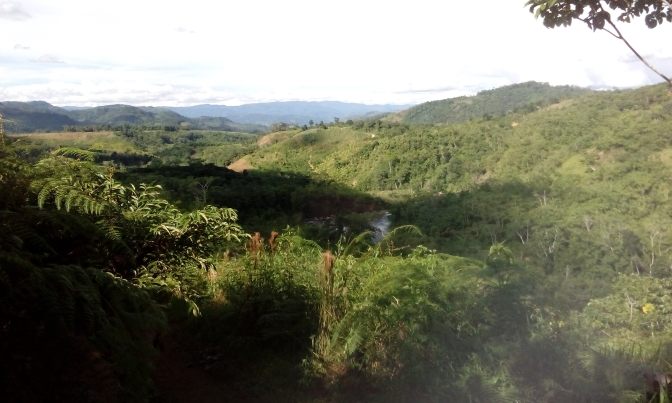
The Journey
Lima is the capital of Peru, a huge city of 9 million people on the west coast of the continent. Firstly I had to get a ten hour overnight bus inland from Lima, over the Andes mountain range to Pichanaki, a small city of about 20,000. Because it´s the wet season from December to April in Peru, the road, which hits 5,000 meters in altitude, was wiped out with mudslides, and I was stranded in Lima for a week longer than I wanted. A bit like Bishop Brennan in Craggy Island when they decided to take the roads in – except worse! Lima is shite, and because the only thing I was looking forward to all week turned out to be Conor McGregor getting his arse handed to him, it didn´t go down as a great week.
Ears plugged and drenched in sweat, I got off the bus in Pichanaki and then took a tuk-tuk through the swarms of little people to get to the next bus station, this time heading for a village called Miricharo. Except it was more of a shack than a station, and instead of buses, you hopped onto the back box of a pick-up truck and were expected to sit on the side. My destination, Kadagaya, was a touch short of Miricharo, which is about an hour from Pichanaki pick-up truck shack, along mountainside dirt roads. The pick-ups are the only form of public transport connecting Kadagaya, Miricharo and the three other villages close by to the real world, in terms of supplies, a post service and people. Aside from that, a lot of men own dirt bikes, but you´ll never see a car or bus.
Bags and bags of rice, spuds and all sorts just about filled the first pick-up that reversed in, but nonetheless, myself and 7 others were told to hop on before it pulled off. The back of the box was missing a screw or two, so it was temporarily kept closed with a skinny piece of wood being put through the loop on one side, and a plastic spoon on the other! So to avoid killing ourselves, we all had to stand up away from the back board – a task not too difficult for your average jungle Peruvian that comes with a nice low centre of gravity as standard. Of course Paddy beanpole here went fucking flying as soon as the truck took off.
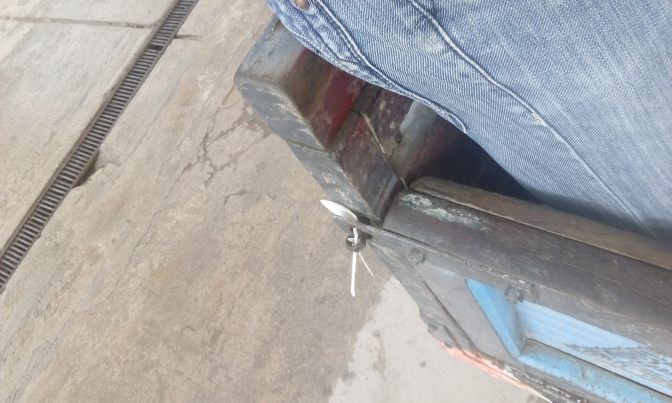
A quick stop to the nearby hardware store to grab a few screws and we´d be off. Seemingly the hardware store only had one screw in stock (Viva Peru!) so it was, thankfully, decided to replace the plastic spoon with the screw and hang on to the piece of wood for the other side. I decided to take my chances by sitting on the back board, along with an auld fella to my left and a young child to my right (both of equal height). One last local tried to climb up just as we were about to pull off, with his dog held up in his outstretched arms – a bit like Billy Zane holding up the poor third-class Irish girl marching through to one of the last lifeboats on the Titanic, screaming ¨I have a child!¨. Alas, we pulled off, and Billy and his dog would unknowingly be safer left behind.
There´s really only one way to carry yourself through living in a third-world setting like this, and that´s the ´When in Rome´ philosophy. Sacrifice comfort and safety, immerse yourself in the culture at hand, and value your life in the cheap way that the locals value theirs. Once you adapt to that frame of mind, you can appreciate the beauty around you, which in this case was the magnificent views of everlasting folding green mountains. Then the fucking piece of wood broke. Once again the back board was out of action as a seat and so I was left standing up and ducking branches for the rest of the trip.
The Arrival
The Kadagaya project is the development of a self-sustaining community using the techniques of a resource-based economy to provide a high-tech, off-grid community for around 40 people. The project is in a relatively early stage, with founders Vladi and Julie hiring local labourers and taking on oversees volunteers such as myself to help design and construct the infrastructure and create the environment. At the beginning (two years ago) there was nothing more than a 6 hectare patch of jungle with road frontage (or dirt-road frontage) and access to the nearby river.
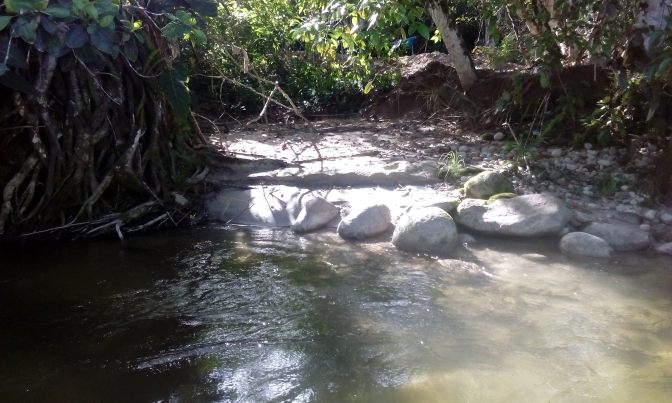
Providing power, renewably of course, to the community is one of the first steps to be taken after Vladi and Julie cut routes through the jungle from the living area to the road and river, and built housing for themselves, their new baby Pachacutec, and the volunteers. Pachacutec, is an ancient Inca name meaning – He who will change the world. No pressure Pachi! For the last year or so, most of the effort has gone into the building of a hydro-electric dam, which is a couple of months away from completion.
Soon after arriving, i took the steep kilometer-long trek down to the river to scrub in with the dam. Up until this point, my only concept of what a Peruvian looked like was from watching Nobby Solano on Match of the Day. Nobby was a left winger for Newcastle United in the 90’s who sometimes filled in at centre midfield, but was definitely more suited to the wing due to his pint-sized proportions. And sure enough, digging out last night´s mud slide from the pit of the dam, I saw a bunch of Nobby Solano´s.
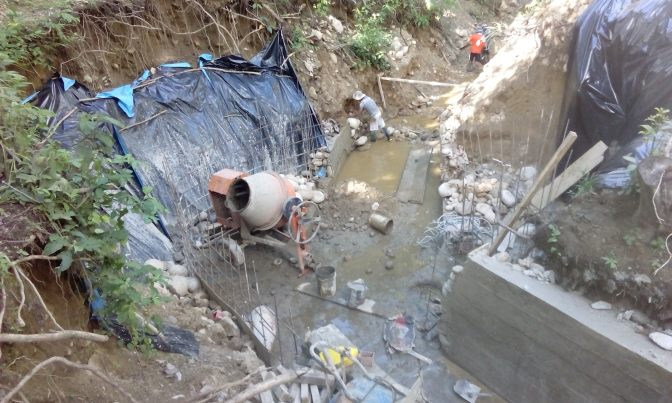
These Peruvians are tough bastards though. Good Jaysus, they can dig. I´ve never done much manual labour before and really wanted to give it a good go. But these boys lifted cement, shovelled sand and dug trenches without breaking stride, while I stood batting away mosquitoes, black wasps and all the other evil jungle dragons, which incidentally didn´t seem to remotely bother the local lads in the slightest.
While my contribution was rewarded with food and accommodation provided, saving me three weeks worth of hostel fees and gringo-priced food and drink, these men, mostly in their early twenties, were earning maybe around $15 for a day´s work – tax free of course as paperwork hasn´t yet been invented in Peru. This money is enough to live and feed their families however, and just like they never complain about the level of back-breaking work expected, they never complain about not having enough, or being relatively poor in the eyes of the rest of the world. Typically, they leave school at about 12 or 13 (which conveniently made me the on-site expert with the measuring tape additions and subtractions). They work 6 days a week, and take Sunday off. So what do they do with themselves on their day off then?
The Football
I couldn´t really think of what to do with my Sunday day off – I already rested the bones on my Wednesday day off, Friday morning off and Saturday afternoon off, so I took a walk to Miricharo with Nalini and Veronica, the other volunteers. I bumped into one of the workers, Marcelo, sitting on his dirt bike, holding a football. He agreed that I could come along without giving any details of what kind of a kick about they were having, and told me to hop on the back of Chino’s bike. Chino (who agreeably was a bit Chinese looking, but no more than the rest of them) had nobody on the back of his bike where as Marcelo was carrying two. Chino sported a nice bit of bandage on his arm, leg and foot, all on one side. At this point, Vladi´s story about one of the workers who had recently had a bike accident came to mind. Right, back to this successful When in Rome mandate again.
It turns out that Miricharo had their own team, as did the three other nearby villages, Alto Pichanaki, Palma Pampa and Cundado, and they played a makeshift tournament every Sunday. Every player threw in about $3 to play – quite a substantial amount for the lads. There were no referee´s (there´s no police or general law in these villages either), and I couldn´t imagine the fee was needed for pitch rental, as I struggled to figure out if the pitch was a grass field half-covered in sand or a sand field half-covered in grass. I later found out that the money was for the pot with the winning team to take all.
Jerseys were produced, which in our case was a locally replicated version of the latest FC Barcelona away strip, except with the team name ´Defensor´ written on the back. The team name means ´Defence´, so early indications seemed that we might not have been the Barça equivalents of the region. Not a problem, I thought. Time for the gringo giant to throw his height around and put Miricharo on the map! (Miricharo as it happens, like the other three villages, is not actually on Google Maps).
What´s your name? Where are you from? The same two introductory questions you get asked in the hostels equally applied here. Americans can never get to grips with the name Ronan, and after a few repetitions, settle on ´Roland´. Spaniards equally so – and they eventually settle for Ronald. It was too much of a stretch for these guys though, so they decided to just stick with ´Gringo’. Fair enough. To my shame, in hostels I usually don´t bother trying to explain that I´m from Drogheda or Louth either, I just say – near Dublin. In this instance though, I soon learned I had to give up my Irish nationality and be from ´near Great Britain´. It still didn´t work though.
¨Pique!¨ Lovely – I get a proper name. Gerard Pique is an abnormally tall centre back for Barcelona in an otherwise team of small to small-ish Catalans, Spaniards, and South Americans. Fairly impressive creativity from the educationally challenged Peruvians, I thought. Pique is equally famous for having married Shakira. The Sunday activity for all the women of the villages is unsurprisingly to watch the men play football, and the guys asked if I´d pick the Shakira of the group. Ah sure it wouldn´t be fair to pick just one, I had to explain. The elder of the group (at times it does have that Amish type order) didn’t bother asking where I played, or trusting that I´d understand his instructions – ¨Tu; Pique¨. A centre back birth so.
Miricharo are shite anyway, and I gave them no extra help. In our first game, Alto Pichanaki destroyed us but it remained scoreless with about ten minutes to go. In probably our only attack, we won a free close enough to goal, and Pique was ordered to put himself in the middle of the box. The cross was perfect too, just waiting for me to head it in from a couple of meters out, only for a swarm of Nobby Solano´s to pile through the back of me. The jeers aimed at me spurred them on to score two late goals and break a gringo´s heart as well as his back. We drew the second game 0-0, where I got taken off early for being too shit. They then just had a penalty shoot-out in place of the third game (Viva Peru!), which we lost, and our $3 would flow into the bustling economy of tournament hosts and winners, Cundado.
The following Sunday, I felt a bit more grind in my teeth, and wanted to do a bit better. My new-found love for Miricharo was strong, but nothing in comparison to my hatred for Alto Pichanaki! The workers told me that the games would start at midday. Now, this wasn´t my first rodeo when it comes to Spanish/Latino time-keeping, so from past lessons learned, I decided to aim for 12.30. The half hour walk to Palma Pampa took about an hour given the heat, and I got there at 1.00. Of course I had to sit around for the next two hours until the lads decided to show up.
They picked me at centre midfield this time and both I and the team did a lot better and scorelessly dominated Alto Pichanaki in the first game – only to concede two late goals again. Alas, it wasn´t to be. A draw in the second game against Cundado set up the customary penalty shoot-out for Game 3. Four village populations laughed and jeered as they sent me up to take the fifth penalty as we trailed 4-3. No pressure! Wouldn´t ya know it, I stuck in the top right corner of the net (same spot as Valencia ´13 as it happens). There wasn´t actually a net in the goalposts of course, and the ball nearly took the head off a young girl standing behind the goal. Maybe she was from Alto Pichanaki though – good enough for her. The next two sudden-death penalties were both scored to make it 5-5, and then, in a world first, everybody just decided to call it a day! A drawn penalty shoot-out. You wouoldn´t even see the likes of that friendliness in Canada.
The After-match
There must have been a few quid left over from the money lost on the first Sunday, and the lads got a bit giddy at the prospect of spending it on a few beers between us all. They asked me if I’d come for a drink and I said yes. Then they explained that they were going to this place called a ´bar´, to buy this stuff called ´beer´, and asked if I´d like to come – I said yes. The third stage of the invite really went into depth about what a beer was and what it could do to you, but how they promised they´d get me home in one piece. A far cry from the international stigma about Irish people that the hostel folk generally direct at an Irishman. These guys never heard of Ireland, or even ´near-Britain´, so of course had no concept of such a stereotype.
This was maybe the most interesting insight I got into the culture. Having seen how affected the Native North Americans have been by the European influence of alcohol, drugs and gambling; it was really surprising that these cultures hadn´t been at all. They work 6 days a week, and use their Sunday as actively as we use our Saturday. They don´t need the customary hangover day that we call Sunday though, because they almost never take a drink, and so they´re fresh as a daisy to go straight back to work on Monday morning. I never saw anybody smoke a cigarette in the three weeks I was there or hear anybody mention a drug or a bet. It may be the third world, but this is truly a clean-cut, mentally and physically healthy society where the people don´t seem to need the sauce that we do to get their kicks.
The Kadagaya Project
In keeping with my surroundings, I maintained a diet practically free of meat, processed sugar, caffeine and alcohol for the three weeks I was at Kadagaya. I was happy to do so, for the same reason that I was happy with the manual labour aspect – I´d never done it before, and it might be good for me. Aside from the one beer and a few bottles of coke bought on match days, I kept with it really well. I actually had a couple of packs of Oreo´s with me, leftover from the bus trip from Lima, which I thought I´d keep in reserve in case the fruit and veg got a bit too much, but I kept away from them until finally cracking on Day 17. And then Day 18. I also threw together my first ever painting in some spare time to help decorate the ceiling space of the living quarters – a tradition that a lot of volunteers do but something I told Julie on the first day that I wouldn’t be able to.

Jungle life and life off the grid was certainly way easier than expected. Shitting was a daunting task at first – I held it in till Day 3! But shitting in a hole can have its entertainment value. It´s basically a game of blind-sided basketball, where you only celebrate the swoosh score. Off the rim is just not good enough I´m afraid.
The hydro-electric dam is a painstaking, huge project that has taken all the focus of the Kadagaya team for the last year but is close to being finished. Other initiatives to come include building an electric car from scratch to be shared within the community, laundry centers for the local village people, rainwater collection systems for drinking water, aquaponic greenhouses where food plants, fish and worms all support each other in a closed loop cycle, a biogas system to turn human waste into fuel for cooking, and generally acting as an educational tool for locals and other visitors. It´s main objective is to serve as a pilot project, to be imitated and improved on by others in the future. More information can be found at www.kadagaya.org, or on the ´Kadagaya´ Facebook page.
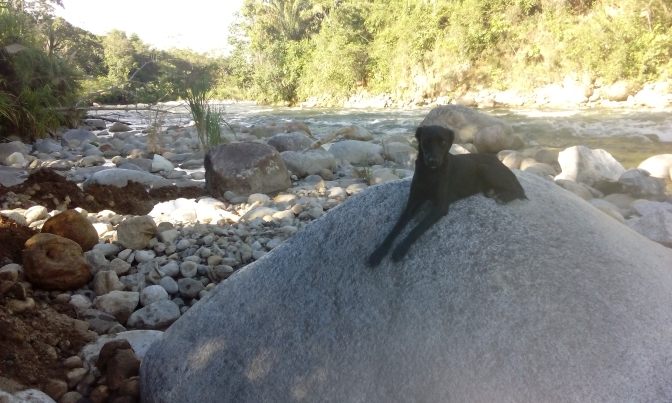
The Experience
It seems quite common among backpackers to volunteer at hostels along their travels to save money by getting free food and accommodation, and maybe even satisfy the Leonardo Di Caprio urge a little and meet slightly more local people. I thought about doing this too, as a way of prolonging the trip through South America, but I got so much more out of this experience, and maybe gave a little more too. All you have to do is go to www.workaway.info and have a look at a whole range of opportunities like this that are available worldwide. (www.workaway.com is a different set up and doesn´t look much good). Onwards to Colombia for me now, and after a bit more hostel craic, certainly another volunteering job at some point though. Colombians couldn´t be any good at football, could they?
Well written, Ronan….apart from some colourful adjectives 😱 Good insight into how the other half live and an eyeopener for us all. Continue to leave your footprint… and charm… as u always do 😘
LikeLike